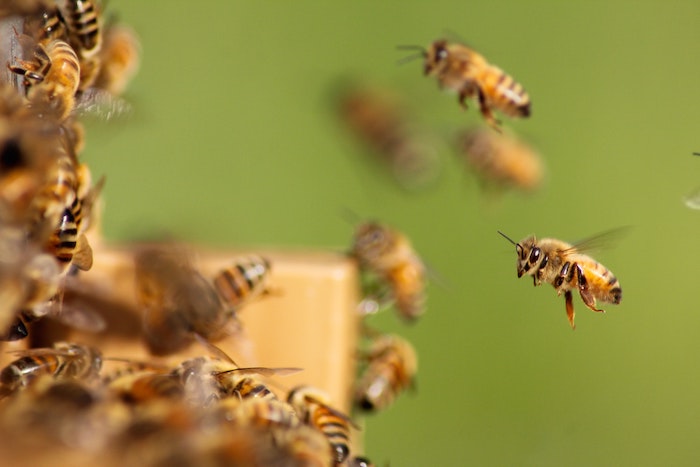Researchers used a forward genetic approach to identify genes that affect a social behavior in honey bees.
For more than 30 years, honey bee geneticist Robert E. Page, Jr. and his colleagues have sought the genes that influence a colony trait that only emerges from interactions between thousands of individual bees — a social phenotype.
Such traits are notoriously difficult to study. As hard as it is to disentangle a gene’s effect on behavior from environmental influences, these challenges are greatly multiplied by the complex interactions between genetically different individuals forming and altering their own social environments. As a result, mapping quantitative trait loci (QTLs) for social behavior long seemed out of reach. A recent paper published in GENETICS surveys the three decades of work that culminated in identifying genes that affect a complex, socially-regulated foraging behavior.
“Everything flowed from our observations of the behaviors that were associated with foraging behavior and division of labor and the resulting impact on the amount of pollen stored in the comb,” says Page, a researcher at Arizona State University. “Over time, we adapted new technologies to ask questions about those phenomena in different ways. By bringing together a host of different toolkits, we were able to build a story of the underlying genetic basis of a very complex social trait.”
Pollen hoarders
In a honey bee colony, some of the bees specialize in collecting pollen and hoarding this protein-rich food in wax cells near the “nursery” where eggs and larvae develop. Some of the bees eat the pollen and produce glandular secretions to feed the larvae; in turn, the larvae produce pheromones that stimulate foragers to collect pollen.
Despite the complexity of factors involved — thousands of individual bees, larvae, their interactions, and their environment — the total amount of pollen stored in the colony is a regulated trait. In a previous study, ASU reseacher Professor Jennifer established this by adding and removing pollen from honey bee colonies and observing the changes in foraging behavior. Each colony had a set level of stored pollen that the bees collectively sought to maintain; when researchers added pollen, foraging decreased until excess pollen had been consumed, and when researchers removed pollen, foraging increased until pollen again reached the colony’s standard level.
Using selective breeding, Page’s team generated strains of honey bees that substantially differ in amount of pollen stored within just three generations. “People have tried for decades to breed bees that store more honey, but honey storage is a very sloppily regulated trait,” says Page. “As long as nectar is available, bees will bring it back and stick it anywhere they can find space in the hive. In contrast, pollen storage offers excellent consistency of measurement.”
Phenotypic and genotypic analysis
Using a wide range of methods, Page and his colleagues studied the phenotypes and genotypes of these strains for 42 generations of selection. Phenotypic mapping revealed that bees in colonies that store more pollen are likely to have more ovarioles (the egg-producing structures in the insect ovary) and to be more sensitive to sugar than those from the colonies with less pollen. One research collaborator, Ying Wang, went so far as to painstakingly graft ovarioles from worker bees into recipients from a colony that produced less, which in turn affected the recipients’ behavior.
When they began to map genetic trait determination, the researchers expected that individual behavior would be more selectable than complex social traits playing out across large groups. Instead, they were surprised to find that genotype explained roughly 41 percent of colony variance in stored pollen but only two percent of individual variance in pollen collection.
Digging down to the genetic level, Page and his colleagues performed QTL mapping for the social phenotype of pollen hoarding along with individual foraging behavior, physiology, and anatomical traits. From the gene lists for each QTL they identified candidate genes of interest based on the phenotypic architecture and assessed them using expression assays and gene knockdown. Ultimately, they identified three genes of special interest, all of which have some association with ovary size. Future studies will involve examining the effects of these genes in developing larvae more closely.
A vertical approach
Page attributes his success in part to his tenacity in pursuing a “vertical approach”—interrogating a single question at every level of influence, starting with social interaction and working down to examine individual behavior, morphological differences, physiology, developmental processes, and genetic variation.
Pursuing this vertical approach over so many years involved the work of countless expert apiculturists, laboratory technicians, students, and fellow researchers alongside Page. “Our success came from combining the right people with the right tools as they became available,” he says. “Everyone who came through my lab made it better and brought something new.”
CITATION:
Societies to genes: can we get there from here?
Robert E Page, Jr.
GENETICS 2021; iyab104
https://doi.org/10.1093/genetics/iyab104































